|
|
||||
| home > extended play | ||||
| Neural
Networks and Information Interchange in Buildings Wolfgang Höhl |
||||
| HOW
SMART ARE OUR NETWORKS? Or, ... where to place cables, how to organize
and connect servers, routers, sensors and actors in smart buildings? |
[10jul2004]
|
|||
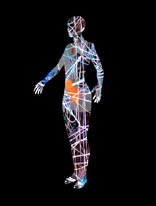 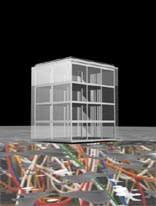 |
Could a deeper understanding of biological network structures be an
advantage to handle communication networks in buildings? Does it maybe
help to create more efficient (and maybe more intelligent) networks? Well, I think it could and indeed there were some very interesting results in the course of this research how to improve our present communication networks in buildings. In a comparison of biological and technological networks the first question will be: Do technological networks in buildings follow a certain network-type and biological networks follow another? Or can we describe a similar structure? The second question will be: When intelligent networks have similar qualities, ... is there a subsequent typology of smart buildings? Such as an evolutionary line of qualities of intelligent buildings? For example: which evolutionary stage have we reached to today and what will be possible tomorrow? And ... which structures can be useful to place cables, routers and servers in buildings? Therefore I will introduce to you two structural models of technological networks in buildings: The model of 'organic backbone networks' in a case study of the recent project R 128 by the engineer Werner Sobek and the one of 'complex exuberant networks'. |
|||
| THE
'EVOLUTION' OF SMART BUILDINGS. So, how intelligent are 'smart buildings'
and what does intelligence mean? Intelligence, as we know it, is inseparably
related to organic life and is characterized by: - Nourishment and exchange of substances - Growth and Mobility - Sensitivity, Self-Regulation and Self-Organization - Reproduction - Self-consciousness, language and social behaviour Some of these characteristics today are realized in architectural projects. In 1960 William Katavolos developed the idea for his 'Organics'. These houses would grow from a self-catalytic substance, would be sensible to the environment, self-regulating and would exchange our waste into re-usable substances. Further examples of growing and moveable constructions are the 'Parascape Structure', 'Variomatic' by Kas Oosterhuis and the 'Walking Cities' by Archigram. |
||||
|
The projects of the 'NH-Pavilion' by Oosterhuis, the vision the 'Growing
House' by John Johansen and the project 'Generator' by Cedric Price
even deal with the idea of self-organization. |
||||
  |
NETWORK STRUCTURES. But is intelligence bound to certain network structures?
Therefore let us have a look at the complexity and the structure of
networks. Widely accepted today in network theory there are three different network models according to their complexity: - Random Networks - Scale-Free Networks - Hierarchical Networks These network types differ from each other in the way of clustering and growth. As with the usual formal qualities of structure, we distinguish in biological as well as in technological networks, so-called 'symmetric', 'asymmetric', 'harmonic' and 'disharmonic' networks. Both (biological and technological networks) are divided into a certain number of parts, both behave symmetric, asymmetric, harmonic or disharmonic to their environment. 'ORGANIC BACKBONES' AND 'COMPLEX EXUBERANT NETWORKS'. Wuchty, Ravasz and Barabasi found that the complexity of biological networks in general seem to follow the topology of scale-free networks. For example, the human nervous system has a structure in three parts. It consists of the |
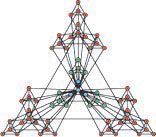 |
||
|
1. central nervous system (brain and spinal cord) 2. the peripheral nervous system (ingoing and outgoing paths for sensors and muscles) 3. vegetative nervous system The structure of the whole nervous system is 'harmonic' to the structure of the organism. Its organization is symmetrical and distinct from neighbouring systems. For example nerves do not penetrate the bones or the blood circuit. But there is another interesting quality: Any biological network follows the assumption of Milgram (that any two points in a biological network can be connected over just six points in between). The networks for building control in the case study of R 128 are divided into five different networks. 1. Climate 2. Electricity 3. Security 4. Sanitary 5. Household All of these five networks have a very low complexity and represent the type of a 'hierarchical network' in a two-parted structure with one central control and peripheral paths. Milgram´s assumption (that any point in a biological network can be connected to another over six other points) could not be affirmed for any of these five networks. |
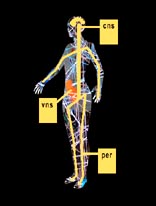  |
|||
 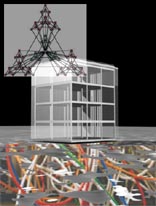 |
The building was erected as a steel-skeleton construction. All of the
five communication networks develop 'harmonically' within the total
shape of the building in a symmetric way. In skeleton constructions
we often will find these homogeneous and harmonically networks with
a central 'spinal cord'. Therefore we can distinguish a first structural
model of so-called 'organic backbone networks'. Interestingly, this basic structure was completed by 'optional loops'. These are circular paths in every floor, reserved for additional links and nodes. Un-used nodes and links can so easily be removed, changed or re-installed. This organization is open to functional changes in the environment. On the contrary, paths for communication technology develop more freely in massive constructed buildings (like the 'in-haus' in Duisburg or the 'tele-haus' in Munich). They often touch or penetrate the construction and other systems and develop in a 'disharmonic' structure, independent from the building's shape. Here we can observe a second structural model, the so-called 'complex exuberant networks', a heterogeneous growing network with un-used rudiments. Now, where to place cables and servers in smart buildings? 'Organic Backbone Networks' with 'Optional Loops' turned out as a practical solution in the project R 128. Maybe this could be an idea for other technological networks within buildings in skeleton construction? Do biomorphic networks, such as 'Organic Backbone Networks' provide more intelligent potential than 'Complex Exuberant Networks' or the other way round? Would a communication network with higher complexity (and operating due to Milgram´s assumption) support more intelligent features? Which advantages would have three-parted technological networks, equipped with a kind of self-sustained 'vegetative nervous system'? These might be interesting questions for future research. Wolfgang Höhl |
|||
| This article refers to a paper presented at the conference Design and Nature 2004 (from June 28 to 30, 2004) in Rhodes, Greece. Published as: Wolfgang Höhl, Neural Networks and Information Interchange in Buildings, in M.W. Collins, C.A. Brebbia, "Design and Nature II – Comparing Design" in Nature with Science and Engineering, Wessex Institute of Technology, WITPress Southampton, Boston 2004, pp. 55-62. All pictures are Copyright 2004 Dr. Ing. Wolfgang Höhl. | ||||
| REFERENCES: Archigram, A Guide to Archigram, Academy Editions, London, pp. 130-133, 1994. W. Blaser and F. Heinlein: R 128 by Werner Sobek, Birkhäuser Verlag, Basel, 2002. R. Carnap, Der logische Aufbau der Welt, 4. Auflage, Verlag Ullstein GmbH., p. 13, Frankfurt, 1979. H. Cruse et. al., Die Entdeckung der Intelligenz oder können Ameisen denken? Verlag C. H. Beck, pp. 21, 22–27, München, 1998. J.C. Eccles, Das Gehirn des Menschen, 6. Auflage, R. Piper & Co. Verlag, pp. 202, 226, 228–231, München, 1990. V. Flusser, "Die Stadt als Wellental in der Bilderflut", in ARCH+, N. 111, pp. 58-63, März 1992. H.W. Franke, "Künstliches Leben – eine Vision", in Spektrum der Wissenschaft - Kopf oder Computer, Dossier 4 / 97, pp. 106-114, 1997. W. Höhl, MedienStädte – Stadtplanung und Kommunikationstheorie, Passagen Verlag GmbH., p. 83, Wien, 2000. J. Johansen, "Organic Process", in Deborah Gans and Zehra Kuz (eds.), The Organic Approach to Architecture, Wiley and Sons Ltd., pp. 95–104, Chichester / West Sussex 2003. W. Katavolos, "Organics", in Ulrich Conrads, Programme und Manifeste zur Architektur des 20. Jahrhunderts, Friedrich Vieweg & Sohn Verlagsgesellschaft mbH., Braunschweig, pp. 155-157, 1981. W. Katavolos, "Organicism", in Deborah Gans and Zehra Kuz (eds.), The Organic Approach to Architecture, Wiley and Sons Ltd., pp. 95–104, Chichester / West Sussex 2003, pp. 89-94, L. Mandl, Linder Biologie - Teil 1, Verlag Gustav Swoboda & Bruder, p. 5, Wien, 1979. S. Milgram, "The Small-World Problem", in Psychology today, 2 / 1967, pp. 60-67, 1967. K. Oosterhuis, HyperBodies – Towards an E-motive Architecture, Birkhäuser Publishers for Architecture, Basel, 2003. K. R. Popper, "Erkenntnis und Gestaltung der Wirklichkeit", in Karl R. Popper, Auf der Suche nach einer besseren Welt, R. Piper Verlag GmbH., 5. Auflage, pp. 30–31, München, 1987. S. Wuchty et. al., The Architecture of Biological Networks, Department of Physics, University of Notre Dame / USA, pp. 5–8, 20, Sept. 2003. |
||||
|
Per
qualsiasi comunicazione laboratorio
|